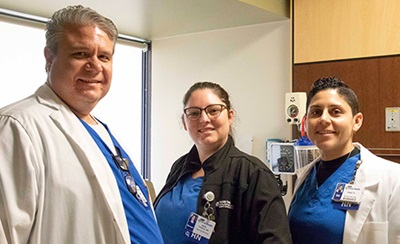Parrie Carroll, 78, had two knee-replacement surgeries done at Texas Health Harris Methodist Hospital Hurst-Euless-Bedford in six months. The second time, she said, was "amazing."
Hard work by a pair of clinical nurse leaders (CNLs) — who found issues with post-operative pain management and communication — made the difference. The changes they pulled together have reduced lengths of stay for total knee replacement patients to one day. Previously, most patients like Carroll stayed about three days, some longer.

The second time around, "I just spent one night," Carroll said. "I came home the day after the surgery, and it was just perfect."
Carroll "was a big motivator for us to see that we were really on the right track," said Sarah Tillotson, B.S.N., RNC, manager of the surgical orthopedic unit where Susan Saniei, M.S.N., R.N., CNL, CNOR, ONC, and Michael Culver, M.S.N., R.N., CNL work.
'At the same table'
"This is a great example of the role of a clinical nurse leader. The idea is to get everybody to talk and be on the same page, be at the same table for the sake of the patient," Tillotson said.
Saniei and Culver decided to look at the issue of length of stay for knee-replacement patients as a Lean Six Sigma Yellow Belt project.
"This is an absolute model for cross-functional problem solving," said Christopher Smith, director of Performance Improvement. "The story behind the story is that Susan and Michael saw a problem, used their Yellow Belt Training, pulled together the surgeon, anesthesiologists , nurses, rehabilitation, lab and nutritional departments as well as the surgeon's office staff to find and address the real root causes of the extended length of stay and that actually solved the problem — a permanent solution to a perpetual problem."
One of Saniei's and Culver's first findings was that physical therapy, whose goal is to get the patient up and walking as soon as possible, was not able to get them moving quickly because of quadriceps numbness from the continuous pain block and lethargy from the use of Patient Controlled Analgesia, where a patient pushes a button to deliver intravenous medication.
Physical therapy was also unaware of the surgeon's post-op physical therapy goals — he expects his patients to walk in the hallway as far as they can on the day of surgery and walk at least 100 feet on the day after surgery, in order to be cleared for discharge the day after surgery. Saniei said Reliable Care Blueprinting™ calls for patients to walk the day of the surgery, but this surgeon was more specific.
Bridging a gap
Saniei and Culver bridged the communication gap by sharing the surgeon's goals with physical therapy.
They investigated further, visiting other hospitals, reading research and sleuthing out the process at Texas Health HEB. Tillotson found that a different kind of cryotherapy — one in which gel packs are placed in a neoprene sleeve — could be easier on the patient and offered more potential for mobility.
"Our previous ice therapy was a simple ice pack with tie strings that leaked often and were otherwise ineffective as they were very difficult to keep in place on the body," Culver said.
They also learned that a different kind of pain block — one that numbed less of the leg — could be just as effective in controlling pain but help patients walk sooner.
Tillotson obtained one of the neoprene sleeves and trialed it on herself. Saniei and Culver enlisted the surgeon's support. And — a key to the whole process — they got everyone involved who touched knee-replacement patients.
"I'm proud everyone was able to pull together and make the changes we needed," Saniei said.
Added Culver, "Not a single person raised objections. Even when we reached outside of Texas Health HEB every single one of them was happy to help."
Everyone on board
Change came quickly when anesthesiology got involved, Saniei said.
"The very next day the changes that we needed for pain control were made," Saniei said. A different type of block was used that successfully numbed the knee, but not the quadriceps in the thigh, leaving patients better able to walk post-surgery.
They also stopped using PCAs and weaned patients to oral medications as soon as possible, leaving them more lucid and better able to walk.
Over time — the project took about a year — everyone was on board. The new cryotherapy was put in place after the appropriate approvals from Infection Prevention and other departments. Dietary services came into play as well: They started bringing up food trays early so patients could get up and move sooner. Lab tests were also taken at times that made it more convenient for patients to start walking.
The lengths of stay started dropping, until the team exceeded the goal of two days and most patients began to be discharged to home health care after one day.
"We knew we could be better, but we wanted to see how we could be great," Tillotson said. "Where we are now is just another point in our journey — we have definitely not hit a destination."
Related News
About Texas Health Resources
Texas Health Resources is a faith-based, nonprofit health system that cares for more patients in North Texas than any other provider. With a service area that consists of 16 counties and more than 8 million people, the system is committed to providing quality, coordinated care through its Texas Health Physicians Group and 29 hospital locations under the banners of Texas Health Presbyterian, Texas Health Arlington Memorial, Texas Health Harris Methodist and Texas Health Huguley. Texas Health access points and services, ranging from acute-care hospitals and trauma centers to outpatient facilities and home health and preventive services, provide the full continuum of care for all stages of life. The system has more than 4,400 licensed hospital beds, 6,400 physicians with active staff privileges and nearly 29,000 employees. For more information about Texas Health, call 1-877-THR-WELL, or visit www.TexasHealth.org.
